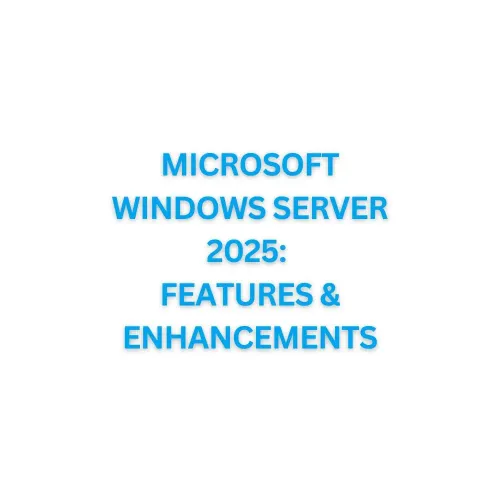Microsoft Windows Server 2025: Features and Enhancements

As we look toward the future of enterprise IT, Microsoft is preparing to launch Windows Server 2025, an exciting new iteration of its renowned server operating system. While the final release is still on the horizon, insights from the preview version suggest significant enhancements and innovative features designed to meet the demands of modern organizations. This post will delve into what we can expect from Windows Server 2025, focusing on its new capabilities and improvements, particularly in Active Directory, security, and performance.
New Functional Level for Active Directory
Advancements in Active Directory (AD)
Active Directory remains a cornerstone of IT infrastructure for businesses around the globe. Its ability to efficiently manage users, devices, and resources has made it indispensable. With Windows Server 2025, Microsoft is introducing a new functional level for Active Directory Domain Services (AD DS) and forest environments. This upgrade aims to facilitate better management and integration of resources, making it easier for organizations to adapt to changing technological landscapes.
Organizations that have been using previous versions will need to consider migration strategies as they transition to this new functional level. The enhancements promise to streamline operations and improve overall efficiency.
New Schema Version
In tandem with the functional level upgrade, Windows Server 2025 will feature a new version of the Active Directory schema—version 90. This version introduces new objects and attributes, further enabling organizations to customize their AD deployments to better fit their unique needs. While specific details are still emerging, the schema update is poised to provide expanded capabilities for organizations looking to leverage their Active Directory environments fully.
Enhanced Security Features
Strengthened Security Protocols
In an era where cybersecurity threats are increasingly sophisticated, Windows Server 2025 emphasizes robust security measures. One notable enhancement is the support for TLS 1.3 in LDAP communications, which ensures secure data transmission between clients and servers. This change not only strengthens security but also aligns with industry best practices.
Additionally, Microsoft has made improvements to encryption methods within Active Directory. The previous reliance on the RC4 algorithm has been replaced with more secure AES encryption for password changes. This shift is crucial for organizations that prioritize data protection, particularly those with sensitive information.
Protected Users Group Enhancements
Another noteworthy feature is the updated handling of the Protected Users group. By default, the SAM-RPC interface will be blocked for users in this group, adding an extra layer of security for high-privilege accounts. Organizations can still modify this setting via Group Policy Objects (GPO), allowing for flexibility based on their security posture.
Performance and Scalability Improvements
Performance Enhancements with ESE and Jet Blue
Microsoft has long utilized the Extensible Storage Engine (ESE) for Active Directory, and Windows Server 2025 introduces optimizations to improve performance significantly. New installations will feature a 32K page size and support for 64-bit Long Value IDs (LIDs). This change not only enhances data processing efficiency but also maintains compatibility with previous versions through an optional 8K page mode.
Organizations looking to upgrade will benefit from these performance improvements, especially as workloads increase. The transition to a 32K page size will require raising the forest's functional level, but the payoff in performance will be well worth it for many businesses.
NUMA Support for Enhanced Resource Management
Windows Server 2025 will also include support for Non-Uniform Memory Access (NUMA), allowing for better resource management in systems with multiple processors. This capability is essential for organizations leveraging high-core-count servers, as it enables Active Directory to utilize CPUs across all processor groups, rather than being limited to a single group.
Preparing for Migration to Windows Server 2025
As Microsoft prepares for the release of Windows Server 2025, organizations must begin planning their migration strategies. The enhancements in security, performance, and Active Directory management are designed to help businesses thrive in a competitive environment.
Strategic Migration Planning
Organizations should assess their current infrastructure and determine the steps needed to transition to the new server version. This includes evaluating existing Active Directory environments, updating schema versions, and ensuring compatibility with legacy systems. Proper planning will help mitigate potential disruptions and maximize the benefits of the new features.
Licensing Considerations
One key aspect organizations should keep in mind during their migration planning is the licensing model for Windows Server 2025. The Standard edition will continue to utilize a 16-core licensing structure, requiring organizations to assess their core count to determine the appropriate licensing needs. This model allows businesses to scale efficiently while managing their costs. As they upgrade to Windows Server 2025, organizations need to ensure compliance with licensing requirements, optimizing their investments while reaping the benefits of the latest features and enhancements.
Conclusion
Windows Server 2025 is set to redefine the enterprise server landscape with its emphasis on security, performance, and innovative features. The updates to Active Directory, enhanced security protocols, and improved scalability are just a few aspects that will help organizations navigate the complexities of modern IT environments.
As we await the official release, it’s clear that Microsoft is committed to providing robust solutions that empower businesses to operate efficiently and securely. By preparing for the transition now, organizations can leverage Windows Server 2025 to build a resilient and future-proof IT infrastructure that meets their evolving needs. With the added consideration of the Windows Server 2025 standard 16 core licensing model for the Standard edition, businesses can plan effectively for both operational and financial success. Stay tuned for more updates as we approach the general availability of this exciting new server operating system!

